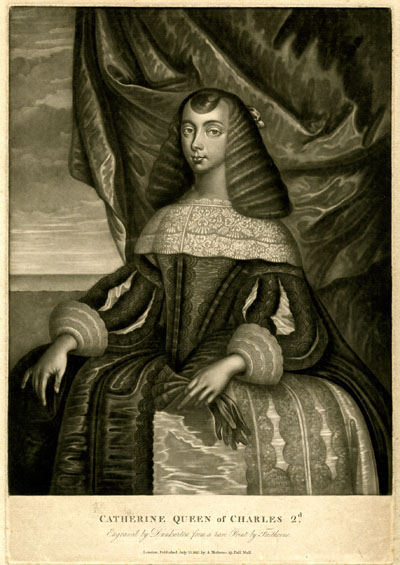It is said that when Catherine of Braganza arrived from Portugal to marry Charles II in 1662, she brought with her a casket of tea. Since the Portuguese had been importing tea to Europe from the beginning of the seventeenth century, Catherine had grown up drinking tea as the preferred everyday beverage.

Catherine’s fondness quickly made it fashionable in England, and first the ladies of the court and gradually those further removed from royal life developed a liking for the elegant drink. Agnes Strickland in her Lives of the Queens of England, published in the 1840s, pictured Catherine of Braganza’s first encounter with the English royal family:
“… the Duchess of York came from London in her barge, to offer her homage to her royal sister-in-law. When she landed, King Charles received her at the garden gate by the waterside, and leading her by the hand, conducted her to the queen, who received her in her chamber. The duchess offered to kiss her hand, but the queen prevented her, by raising her in her arms and saluting her. The royal family then seated themselves near the queen’s bed, and conversed with her. It is probable that they then partook of Catherine’s favorite beverage, tea, which became a fashionable refreshment in England soon after her marriage with Charles II, though not exactly introduced by her.”
When tea was consumed in such a grand setting, it was generally in the company of female friends within a bedchamber or closet (a small room for entertaining guests near the bedchamber). The tea itself and the delicate pieces of porcelain for brewing and drinking it were displayed in the closet. Inventories for wealthy households during the seventeenth and eighteenth centuries list tea equipage not in kitchens or dining rooms, but in these small private closets or boudoirs.
On the River Thames, just west of London, the Duchess of Lauderdale lived in splendor at Ham House. Married to one of the king’s leading ministers, she had the financial resources that enabled her to purchase the latest fashions. The diarist John Evelyn described the house as “furnished like a great Prince’s with tapestries, damask, velvet, mohair on walls, bedsteads, chairs upholstered in luxurious fabrics.”
By 1679, the Duchess’s “white closet,” a small room close to her bedchamber where she received visitors, contained a Japan box for sweetmeat and tea and a heavily carved and gilded tea table where the Duchess brewed tea with water from her silver “Indian furnace [urn]” and served it to her close friends.
Sign up to receive special offers, discounts and news on upcoming events.